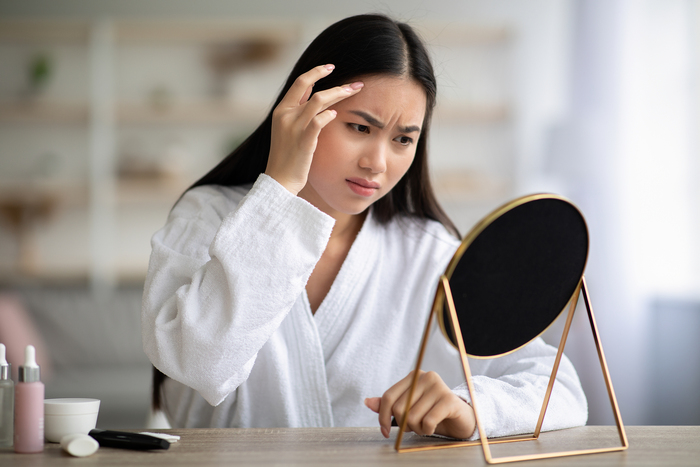Ageing is a gradual and continuous natural process that begins as early as early adulthood. As we age, our organ functions start to gradually decline, and this includes our skin, which happens to be the body’s largest organ. Skin changes stand out as some of the most noticeable indicators of ageing. Typical signs of skin ageing encompass wrinkles or fine lines, sagging, the emergence of eye bags or dark under-eye circles, a lacklustre and uneven complexion, among others.
In the ageing process, our outer skin layer becomes thinner, which can contribute to the development of eye bags. Furthermore, we experience a loss of fat and collagen in our skin, resulting in sagging and a paler appearance. Prolonged sun exposure over the years can increase the likelihood of pigmented spots like age spots or “liver spots” appearing on sun-exposed areas such as the forehead and cheekbones.
Beyond natural ageing and sun exposure, lifestyle factors like diet, sleep, and stress can also lead to premature skin ageing.
In TCM, premature skin ageing is affected by 2 main factors:
-
- Premature ageing of organs
As we age, our organ function naturally declines, which also shows on our skin. Here are a few examples of how organ health can be linked to facial complexion.- Dry skin is often associated with Lung Yin deficiency. This condition may also lead to other dry symptoms like dry eyes, a dry nose, and a dry throat.
- Dark under-eye bags or circles can be caused by Kidney Deficiency. Other accompanying symptoms may include frequent night urination and unexplained lower back pain, which tends to worsen with physical exhaustion.
- A dull or yellowish complexion may be linked to Spleen Qi deficiency. This condition is often accompanied by digestive symptoms such as bloating after eating, gassiness, soft or irregular stools, and fatigue.
- Sagging skin, fine lines, and wrinkles are typically caused by a combination of Lung Yin and Spleen Qi deficiency. These symptoms are often accompanied by digestive and dryness-related symptoms.
- Premature ageing of organs
-
- External sensitivity to pollutants/environment
As we age, our skin undergoes various changes, including thinning, dryness, reduced elasticity, and increased sensitivity to external stimuli. This sensitivity to external factors is often associated with Lung Qi deficiency, which is a natural part of the ageing process. Lung Qi deficiency may also be a natural body constitution (happens from birth), commonly seen in individuals with eczema, sinus issues, and childhood asthma.In TCM theory, our Lungs work closely with the skin to function as the “barrier” that protects us from external pathogens. As such, Lung Qi deficiency will result in the skin barrier weakening and becoming sensitive to external factors like heat, dust, pollen and more. Other symptoms of Lung Qi deficiency include immune-related symptoms such as being prone to falling ill or having long colds.TCM believes the way to prevent premature skin ageing and achieve a healthy, glowing complexion starts from within. Nourishing Qi and Blood ensures sufficient nourishment for our organs to function healthily, while maintaining a healthy Yin and Yang balance can help to prevent our body’s temperature and energies from fluctuating to maintain a stress-free environment for our skin to flourish.
- External sensitivity to pollutants/environment
Promoting youthful skin with TCM
1. Wrinkles and Fine lines
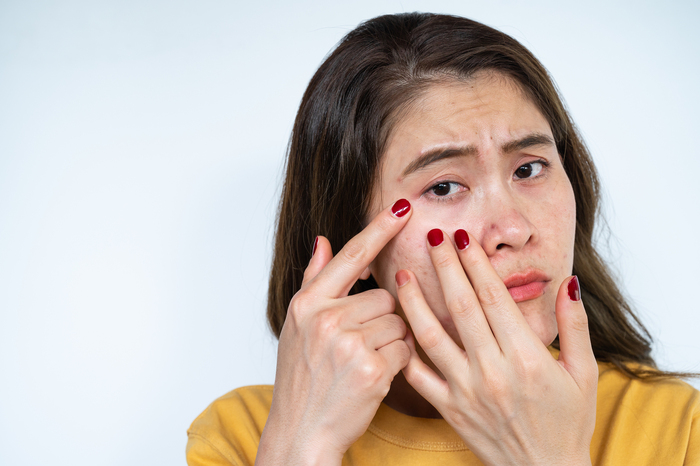
Wrinkles and fine lines can be caused by sun damage, skin thinning, and collagen loss. Collagen gives our skin structure and enables our skin to stretch and move easily. Collagen loss causes elastosis – the reduction of our skin’s strength and elasticity. Elastosis is more noticeable in sun-exposed areas and causes the appearance of wrinkles and fine lines. In TCM, wrinkles and fine lines are related to Lung Yin deficiency and Spleen Qi deficiency.
TCM treatments for wrinkles and fine lines
Replenishing collagen through collagen supplements or facial treatments are popular and effective ways to reduce fine lines and wrinkles. However, ensuring that our Lung Yin and Spleen Qi are taken care of is also crucial. In the clinic, we usually achieve this via herbal medication. Herbs such as Sha Shen, Mai Dong, Pi Pa Ye are commonly used to nourish Lung Yin and can help to alleviate dryness-related symptoms like dry mouth, nose, eyes, and throat. For patients who suffer from Spleen Qi deficiency, herbs like Huang Qi, Bai Zhu, and Dang Shen can help to improve complexion while also giving you a digestion and energy boost.
Apart from herbs, acupuncture is also becoming an increasingly popular way of treating wrinkles and fine lines naturally. Insertion of fine needles along acupoints in the face stimulates local blood circulation and collagen production, which boosts elasticity and reduces appearance of wrinkles. Despite the use of needles, facial acupuncture is not as painful as many might think as the needles used are extremely small and fine.
Tech-enhanced Therapies for wrinkles and fine lines
i. Electro-Lymphatic Therapy (ELT)
For individuals who are scared of needles, the Electro-Lymphatic Drainage Therapy (ELT) is a painless and non-invasive option to consider. ELT promotes healthy lymphatic drainage in the face and the body, which boosts complexion by ensuring clearance of toxins from the face and neck area. Toxin build-up in the lymphatic system can also cause poor blood circulation to the face and result in many skin issues over time. ELT is conducted using an FDA-approved machine and feels like a gentle, relaxing massage. The recommended frequency for ELT is once a week and lasts 60-80 minutes each time. People with tense neck and shoulders may experience immediate relief and lightness after one session and an improvement in skin complexion over a few sessions.
ii. Cell Pro Therapy (CPT)
The Cell Pro Therapy (CPT) is another painless and non-invasive alternative and is usually paired with an ELT session. Negative ions are also known as antioxidants and help to prevent premature cell ageing by scavenging free radicals and protect our cells from oxidative stress. Through skin surface area contact, the body absorbs a large amount of negative ions over a treatment duration of 20 minutes. After detox via the ELT, Negative ions help to activate cell recovery, thus improving cell health by boosting cell absorption of nutrients and useful materials. Other benefits of negative ions include improving the body’s abilities in stress management, boosting the immune system, and promoting blood circulation.
Lifestyle and Dietary recommendations to reduce wrinkles and fine lines
A diet rich in collagen and healthy fats can help to prevent wrinkles and fine lines. The Chinese believe that foods like braised sea cucumber, braised pork knuckle, and peach gum jelly are high in collagen and thus consume them to improve skin and joints health. White fungus is an ingredient commonly used in Chinese desserts which not only improves skin complexion, but can nourish Lung Yin and relieve dryness as well. Herbs like Huang Qi and Bai Zhu can also be incorporated in soups and porridge to nourish Spleen Qi for an age-defying complexion.
Wrinkles and fine lines form the most easily around the eyes, so it is important to care for these areas as well. Prolonged screen time and insufficient rest can cause us to squint unconsciously, which can worsen wrinkles. As such, forming good habits like taking breaks from looking at the screen and sleeping early are equally important in preventing wrinkles and fine line formation.
2. Pigmentation
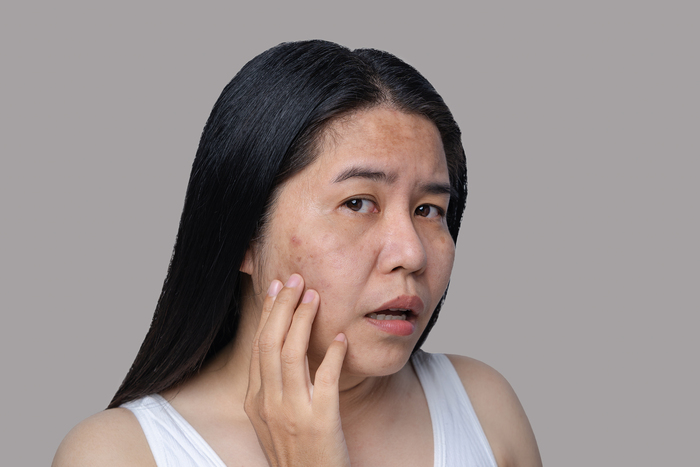
Skin pigmentation issues like age spots are caused by excessive melanin production of the skin in response to prolonged exposure to the sun. In TCM, age spots are also called liver spots and they are believed to be caused by Kidney and Liver Yin deficiency, as well as Liver Qi stagnation that can lead to poor blood circulation in the face.
TCM treatments for pigmentation
Acupuncture and TCM herbs are also usually the first line of treatment for pigmentation issues. Kidney and Liver Yin nourishing herbs such as Liu Wei Di Huang Wan and Liver Qi circulating herbs such as Xiang Fu and Chai Hu are commonly used. Facial acupuncture can improve circulation of blood to the face and may also be paired with acupoints on the legs such as San Yin Jiao and Tai Chong which can nourish Kidney and Liver Yin and circulate Liver Qi respectively.
Tech-enhanced Therapies for pigmentation
Similarly, the ELT and Cell Pro Therapy (CPT) are both great options for those who dislike needles. Through enhancing detox, the ELT can help to decongest the detox organs like the liver and kidneys and alleviate pigmentation by promoting healthy blood and lymphatic circulation. Meanwhile, negative ions act as a source of antioxidants to keep our cells and organs young and healthy.
Lifestyle and Dietary recommendations to reduce pigmentation
A diet that is high in antioxidants and vitamins can help to prevent pigmentation issues. Pomegranates are a rich source of polyphenols which can combat free radical damage and lighten dark spots. Carrots and leafy greens like spinach, kale, and broccoli contain antioxidants and carotenoids which protect against oxidative stress and prevent pigmentation. Citrus fruits like orange and lemon are rich sources of vitamin C which is famous for its anti-pigmentation and brightening properties. Using skincare infused with antioxidants and vitamin C may also help to reduce pigmentation issues.
Apart from diet, here are some lifestyle changes you can consider making to prevent pigmentation. Late nights can worsen Kidney and Liver Yin deficiency, so it is advisable to go to bed by 11pm at night. According to the TCM clock, 11pm is when the Gallbladder detoxes, so sleeping before that can conserve the body’s Yin energy and help the body get rid of toxins. Managing stress also keeps pigmentation at bay as Liver Qi stagnation caused by stress contributes to age spots, so don’t forget to take care of your mental health as well!
3. Dullness
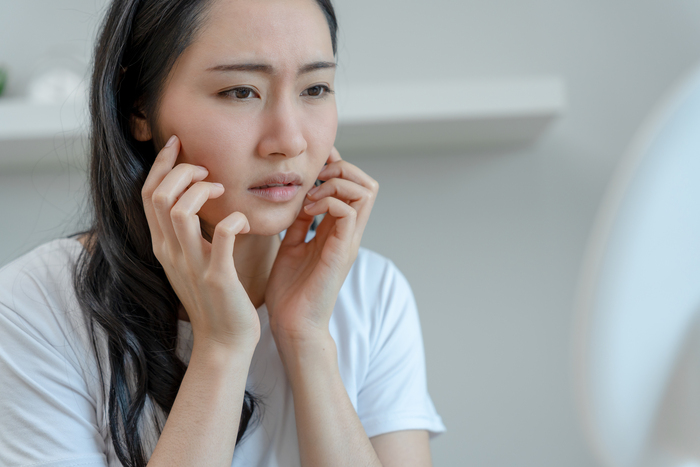
Dull skin and uneven complexion is caused by loss of collagen and hydration, prolonged sun exposure, and poor blood circulation in the face. In TCM, these issues are linked to Spleen Qi deficiency.
Our Spleen is one of the key digestive organs in TCM theory. When food enters our body, they are first absorbed by the Stomach before they are refined and converted into useful materials for use by the body. These useful materials are called “水谷之精” which translates to “essence of water and food” and contributes to the formation of Qi and Blood which are the key building blocks in our body. Healthy Qi and Blood reflects on our skin in the form of rosy cheeks and glowing complexion. Pale or dull-looking complexion is often an indication of Qi and Blood deficiency, which may result from either overuse or insufficient formation. Overuse of Qi and Blood usually happens during excessive exercise, chronic fatigue, or during the menstrual period for ladies. Insufficient Qi and Blood formation happens when the Spleen’s ability to convert nutrients into useful building blocks reduces, otherwise known as Spleen Qi deficiency.
TCM treatments for skin dullness
In terms of treatment, tcm herbs can be used to nourish Spleen Qi and tonify Qi and Blood to boost skin complexion. Commonly used Spleen-nourishing herbs include Huang Qi, Bai Zhu, Fu Ling, Dang Shen. These herbs are also known to nourish the body’s overall Qi as well. Dang Gui and Shu Di Huang may also be added to help nourish the Blood for rosy-looking cheeks!
Apart from herbs, facial acupuncture and Guasha can also be done to alleviate dull-looking skin. Both improve complexion by promoting local blood circulation. Guasha can also boost lymphatic circulation in the face and neck area, which aids in the removal of waste materials from our head for a clear and glowy complexion.
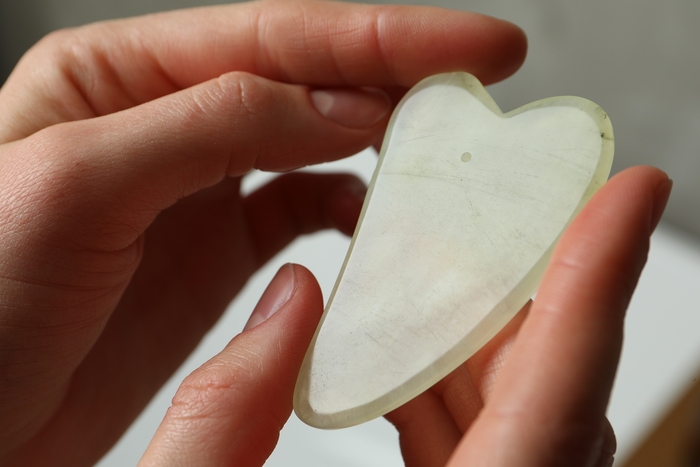
How to do Guasha for lymphatic drainage and achieve glowing skin at home?
What You’ll Need:
- Guasha tool (use a jade or rose-quartz gua sha tool that is made for facial gua sha)
- Facial oil or serum (optional)
- Clean face and hands
- A quiet and relaxed environment
Follow/ Watch Physician Foo’s 4-step Guasha routine
View this post on Instagram
Or follow these step-by-step instructions below
Steps:
- Begin by massaging the clavicle area, spending 30 seconds to 1 minute on each side.
- Utilise the Guasha tool’s longest, rounded edge. Start from the middle of the forehead, moving outward, and vertically scrape from the eyebrow to the hairline in repetitive motions. Once you reach the end, scrape from the middle of the hairline to the temples, and briefly massage the area for 10 seconds. Then, scrape downward toward the clavicles. Repeat this process on the other side of your face.
- With the same long edge of the gua sha tool, target the mid-part of your face. Use horizontal strokes to scrape from the nose to the cheekbones, working your way down. Always finish the strokes at the front of your ear. After completing this for the mid-part of your face, massage the tender point at the front of your ear before scraping downward toward the clavicles. Repeat this on the other side of your face.
- Conclude with jawline scraping. Using the v-shaped, sunken part of the gua sha tool, begin at the chin and scrape along the jawline toward the back of the ears. Repeat this a few times before briefly massaging the sensitive acupoint behind the earlobe for 10 seconds and then scraping downward toward the clavicles. Repeat on the opposite side of your face.
- Finish by massaging the clavicles for another 30 seconds to 1 minute on each side.
Note:
- Always use gentle pressure. Guasha should never cause pain or discomfort
- Do this 2-3 times a week for best results
Remember that while Gua sha can provide many benefits for your skin and lymphatic system, it’s important to consult with a dermatologist or skin care professional if you have specific skin concerns or conditions.
Lifestyle and Dietary recommendations to combat skin dullness
An unhealthy diet can also cause a dull-looking complexion. Avoid heaty, oily, spicy, or processed foods as these will increase inflammation and affect healthy blood circulation to our face. Instead, eat foods that are nutritious and high in vitamins and antioxidants like fruits and leafy greens. Sleep early and drink at least 3L of water a day to ensure sufficient hydration for glowy and plump-looking skin!
4. Sagging and Dark eye circles
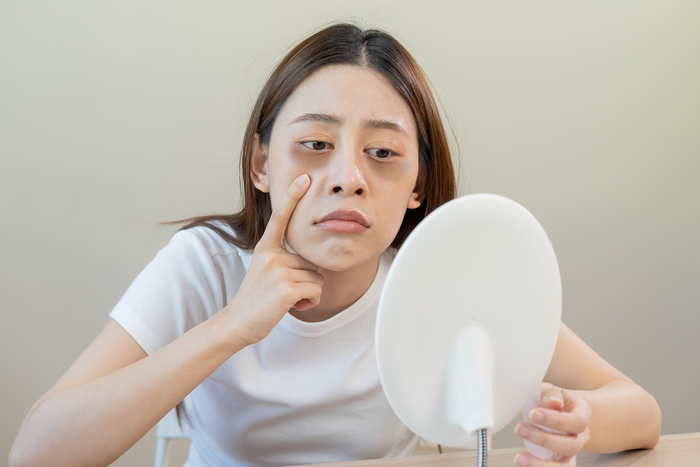
Sagging and dark eye circles and eyebags are also amongst the most common ageing skin concerns. Skin sagging is also caused by a loss of fats and collagen and is viewed and treated similarly to wrinkles and fine lines. Dark eye circles and eyebags are caused by skin thinning which causes blood vessels underneath the eyes to look more obvious. In TCM, eye circles and bags are linked to Kidney deficiencies. Common treatments include Kidney-nourishing herbs, facial acupuncture to promote blood circulation, and facial gua sha and ELT to promote lymphatic drainage in the face.
As with other premature skin ageing concerns, healthy diet and habits are key to preventing sagging and dark eye circles and eyebags. Getting enough sleep and getting in bed early can sometimes improve eye circles and bags significantly. If you struggle with skin sagging, try including facial gua sha as part of your daily skincare routine. Avoiding processed foods, drinking plenty of water and eating foods that are high in vitamins and antioxidants keep our skin looking young and vibrant. And as always, don’t forget to wear sunscreen when you’re heading out to protect your skin against the sun’s harmful rays!
Your healing is the most important!
TCM and Western medicine’s perspectives on ageing skin differs slightly, but they share the common belief that healthy skin comes from within. While external protection and treatment such as sunscreen, acupuncture, and facial treatments are important, our internal health is equally important in determining the rate at which our skin ages. Combining external treatments like facial acupuncture, gua sha, and ELT with internal conditioning like tcm herbs and a healthy diet can help to speed up our body’s skin recovery, thereby slowing down skin ageing.
If you are unsure of your own skin condition and how to embark on your #goodskinhealth journey, remember to always arrange a consultation with a qualified TCM practitioner to understand more about your health and find out which treatments suit you best. Cheers to great health and glowing from within!
—
This article is written by Physician Foo Shan Ju.
Physician Foo Shan Ju (Oriental Remedies Group, Singapore), a registered TCM physician certified by the Traditional Chinese Medicine Practitioners Board (TCMPB).
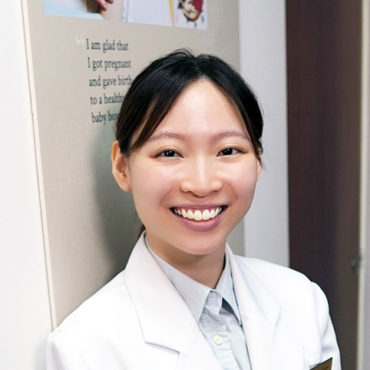
Note: all words in Italics mentioned henceforth refer to the TCM organ system and not the anatomical organs/terms referenced in western medicine.
Disclaimer:
The content on this page is for information and educational purposes only. Such medical information may relate to disease, injury, drugs and other treatments, medical devices and/or health products. Medical information does not amount to advice, and if advice is needed an appropriate professional help should be sought. The disclaimer asserts that no warranties or representations are given in respect of the medical information, and that the website operator should not be held liable if a user suffers any injury or loss after relying upon the medical information.
Any devices used for technology-enhanced therapies are intended for use only for general well-being purposes or to encourage or maintain a healthy lifestyle, and is not intended to be used for any medical purpose (such as the detection. diagnosis, monitoring, management or treatment of any medical condition or disease). Any health-related information provided by this device or software should not be treated as medical advice.

